INTRODUCTION
The subgenus Chrysosarus Mitchell is one of the major subgenera of Megachile Latreille in the Neotropics, currently including 60 nominal species (Moure et al., 2007; Raw, 2007; Ascher & Pickering, 2020). The subgenus includes nearly all of the Neotropical species which completely lack cutting edges in the female mandible. As presently understood, the subgenus also includes a few species which have a small cutting edge on the lower margin of the third tooth, partially fill ing the second interspace, between the second and third teeth. Raw (2006) proposed the new subgenus Austrosarus for three such species from Brazil. Besides the presence of the small cutting edge in the female mandible, these three species bear no other characteristics that allow to separate them from Chrysosarus, and conse quently Austrosarus has been placed in the syn onymy (Gonzalez, 2013; Melo & Parizotto, 2015; Gonzalez et al., 2019; Roig-Alsina & Torretta, 2021). Later, Melo & Parizotto (2015) described two further species of Chrysosarus with a small cutting edge in the female mandible.
According to current understanding of Megachile phylogeny (Trunz et al., 2016; Gonzalez et al., 2019) the lack of cutting edges in Chrysosarus is a derived condition for the subge nus, since all immediate outgroup subgenera in the cladograms have cutting edges. The presence of a small cutting edge is then a plesiomorphy within the subgenus, and cannot be taken as evi dence of relationship for the species bearing it. The possibility that the cutting edge has arisen de novo in some species needs to be clarified in a comprehensive phylogenetic analysis of the sub genus, beyond the scope of the present contribu tion.
The present contribution deals with several species of Chrysosarus from Argentina, Chile and Uruguay which have a small cutting edge in the female mandible. The species with this condi tion form an heterogeneous assemblage, with the exception of four species which share a number of common features. The other species seem to be related to species that completely lack cutting edges, and not to each other.
The aim of this study is to contribute to the knowledge of the morphological diversity within the Chrysosarus lineage, to describe four new species, to clarify the identity of two species de scribed over a century ago, and to provide illus trations and distributional data for all treated species.
MATERIAL AND METHODS
Morphological terminology follows Michener (2007) for general terms, Michener & Fraser (1978) for mandibular structures, and Mitchell (1980) for terminology of the hidden sterna of the male. The maximum diameter of the me dian ocellus (MOD) is used as a reference to express the length of the pubescence and other structures, and the diameter of punctures (PD) to indicate the size of the intervals between the punctures. The metasomal terga (T) and sterna (S) are identified with Arabic numerals. The sex of the specimens is indicated by F, female, and M, male. Distribution maps were constructed using SimpleMappr (Shorthouse, 2010).
The material studied belongs to the fol lowing institutions: Facultad de Agronomía, Universidad de Buenos Aires (FAUBA), Instituto Argentino de Investigación de Zonas Áridas, Mendoza (IADIZA), Museo Argentino de Ciencias Naturales, Buenos Aires (MACN), Museo de La Plata, La Plata (MLP), Muséum National d’Histoire Naturelle, Paris (MNHN), Natural History Museum, London (NHMUK); Snow Entomological Collection, Lawrence, Kansas (SEMC); Zoologisches Museum der Humboldt Universität, Berlin (ZMB).
SYSTEMATICS
Genus Megachile Latreille
Subgenus Chrysosarus Mitchell
Remarks. Currently, five species with a small partial edge in the second interspace of the fe male mandible have been included in the sub genus Chrysosarus, all described from Brazil: Megachile canastra Melo & Parizotto, M. can danga Raw, M. diamontana Melo & Parizotto, M. diasi Raw, and M. frankieana Raw (Melo & Parizotto, 2015; Raw, 2006). A further species, the Chilean Megachile euzona Pérez, has been reported as having a small edge (Gonzalez et al., 2019), although barely visible in frontal view.
The subgenus Chrysosarus in Argentina, Chile, and Uruguay includes several species with a partial cutting edge on the third tooth of the female mandible, although with different degrees of development of the edge. The species are listed below taking into account features both of the females and the males. Megachile interjecta Vachal, and M. platensis n. sp. occur in Argentina and Uruguay; M. euzona Pérez, and M. tetrazona Friese occur in Argentina and Chile; and M. basi macula n. sp., M. cubiceps Friese, M. sancticlau dii n. sp., and M. simpliciclypeata n. sp. only oc cur in Argentina.
Megachile interjecta stands apart because of the mandibular structure of the female. Both the second and the third interspaces have a par tial cutting edge (Fig. 1A). We know of no other Chrysosarus with this type of mandible. The hid den sterna and the basitarsus of the male relate this species to M. platensis n. sp.
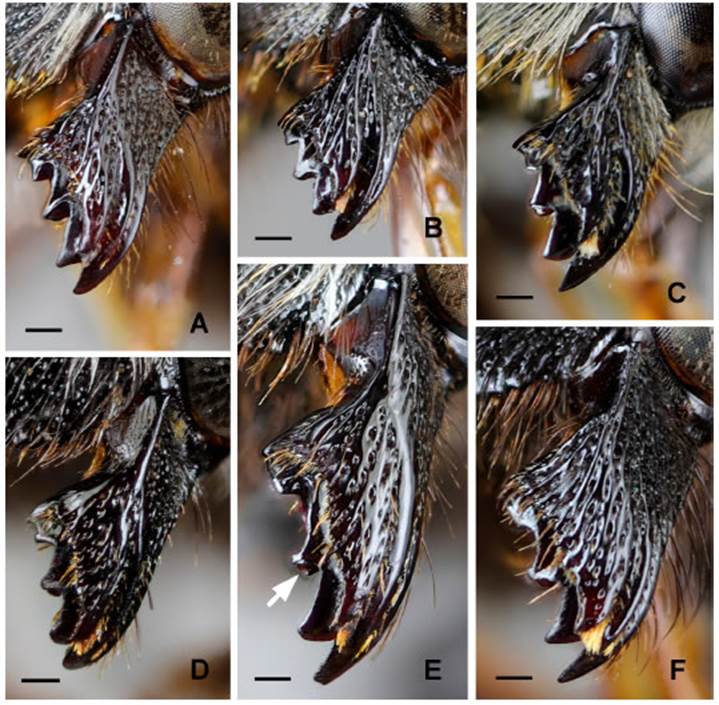
Fig. 1 Megachile (Chrysosarus) species, left mandible of females. A. M. interjecta Vachal. B. M. platensis n. sp. C. M. sancticlaudii n. sp. D. M. basimacula n. sp. E. M. cubiceps Friese (arrow indicates cutting edge on lower margin of third tooth, partially filling second interspace). F. M. tetrazona Friese. Scale lines = 0.2 mm.
Megachile sancticlaudii n. sp. has a clearly visible cutting edge (Fig. 1C). The female is read ily recognized by the complete sternal apical bands of plumose hairs below the scopa on S2-S5. The male has an angle on the lower margin of the mandible, and the preapical carina of T6 bears strong spiniform teeth on each side of the median emargination.
The two species M. platensis n. sp. and M. simpliciclypeata n. sp. present a rudiment of cut ting edge (Fig. 1B), difficult to see when the man dibles present some wear. They are included to illustrate the extent of variation of the structure within Chrysosarus. As in Megachile interjecta, females have lateral apical bands of plumose hairs under the scopa.
Megachile euzona species group. This group is very distinctive and different from all other species groups in Chrysosarus. Its species are distinguished at first sight by their sturdy body form. The group may deserve subgeneric recog nition and further phylogenetic studies may res urrect the name Stelodides Moure for the group.
The cutting edge in the second interspace varies in these species from rudimentary in M. euzona, moderate in M. basimacula (Fig. 1D) and M. tetrazona (Fig. 1F) to well developed in M. cu biceps (Fig. 1E). The four species included in the group are quite dissimilar in aspect, and each of them is singled out by peculiar features, such as the enormous head and mandibles of the female M. cubiceps, the color pattern of M. euzona, the shape of the clypeus of M. basimacula, or the unique forebasitarsus of the male M. tetrazona.
The females of the four species have an ovoid metasoma, which gives them an aspect of ro bustness. The second and the third metasomalterga in these species are of similar width. Other species currently in Chrysosarus have a cordate metasoma, with the second metasomal tergum wider than the third. Two characteristics tabu lated by Gonzalez et al. (2019) for M. euzona are also present in the other three species. One of them refers to the outer premarginal impressed line of the female mandible, which bears stiff se tae on all its length, while in other Chrysosarus such setae are usually restricted to the portion that borders the fourth tooth. The second one refers to the hypostomal carina, which curves to wards the cranial acetabulum. Furthermore, the strip that borders the mandibular socket poste riorly is strongly thickened in the four species. Apical bands of plumose hairs under the scopa are absent in these species.
The males of M. cubiceps, M. basimacula, and M. euzona share a strikingly similar anterior ba sitarsus, which is flattened, broadest subbasally, with a sinuous outer margin bearing a fringe of short hairs, and with a basal black spot on the undersurface (Fig. 10A-C); other tarsomeres lack black spots on the undersurface. The foretarsus of other Chrysosarus bears as a rule a black spot on the undersurface of the second tarsomere, although in some species black spots may also occur on the third and fourth tarsomeres. The sharply carinate outer margin of the foretibia of the males is another feature that separates the four species from other Chrysosarus. The hid den sixth sternum of the males is also charac teristic. Except in M. euzona, the apical lobes of the postgradular area of S6 are strikingly large and broadly rounded, and the pregradular lateral hairs form a dense tuft of plumose hairs.
Megachile (Chrysosarus) interjecta Vachal
(Figs. 1A, 2A-F, 5A, 6A, 7A, 11D)
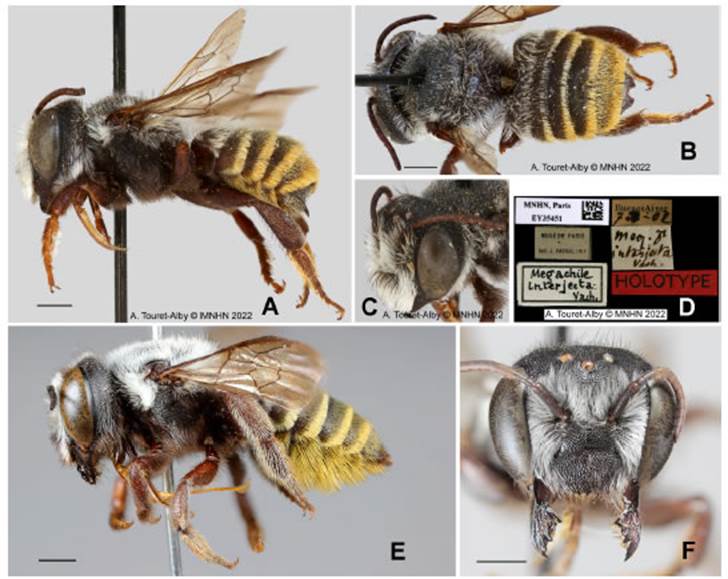
Fig. 2 Megachile interjecta Vachal. A-D, male holotype (MNHN, Paris, images published with permission). A. Lateral view. B. Dorsal view. C. Anterolateral view of head. D. Labels. E-F. Female. E. Lateral view. F. Face. Scale lines = 1 mm.
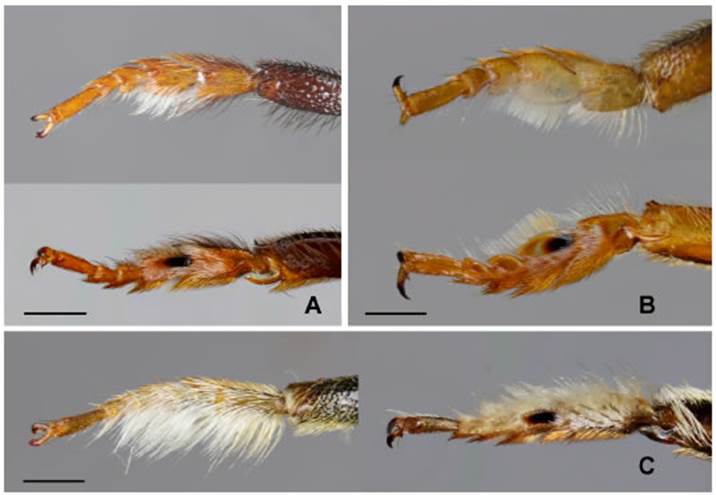
Fig. 5 Megachile (Chrysosarus) species, anterior tarsus of male. A. M. interjecta Vachal, dorsal (above) and ventral (below) views. B. M. platensis n. sp., dorsal (above) and ventral (below) views. C. M. sancticlaudii n. sp., dorsal (left) and ventral (right) views. Scale lines = 0.5 mm.
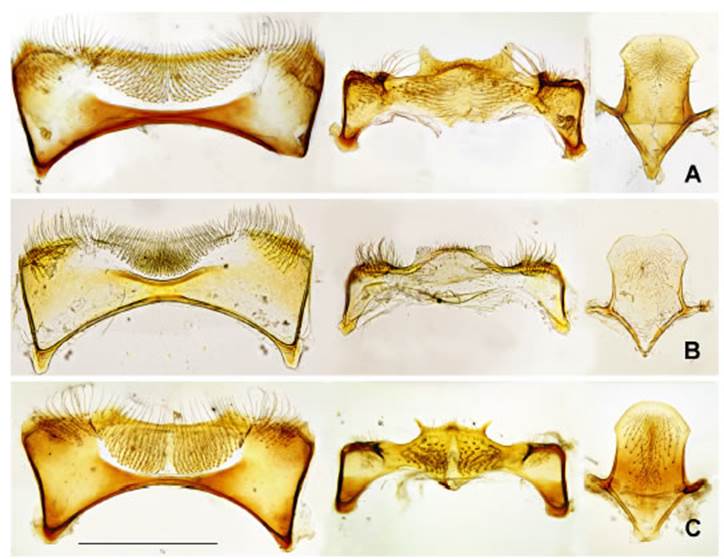
Fig. 6 Metasomal sterna of Megachile (Chrysosarus) males: S5 (left), S6 (center), and S8 (right). A. M. interjecta Vachal. B. M. sancticlaudii n. sp. C. M. platensis n. sp. Scale line = 1 mm.
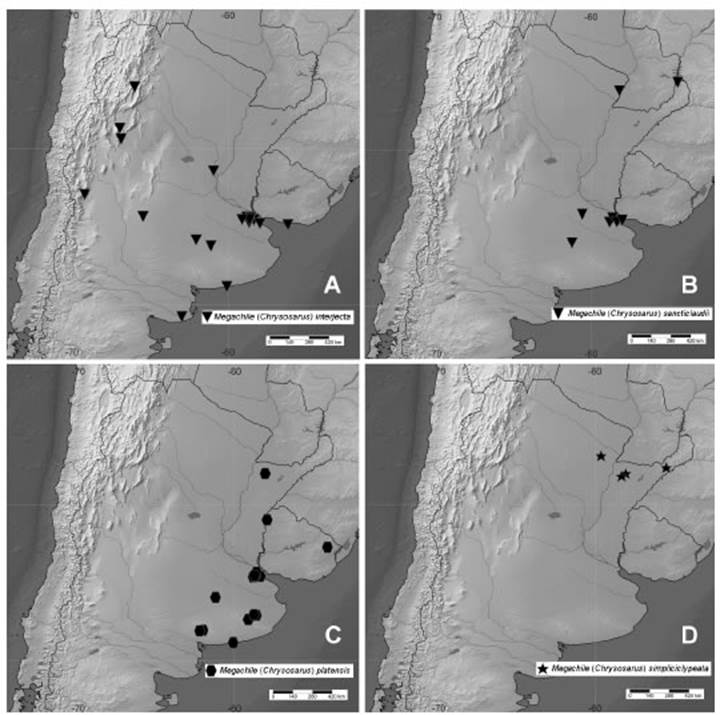
Fig. 7 Distribution maps of Megachile (Chrysosarus) species. A. M. interjecta Vachal. B. M. sancticlaudii n. sp. C. M. platensis n. sp. D. M. simpliciclypeata n. sp.
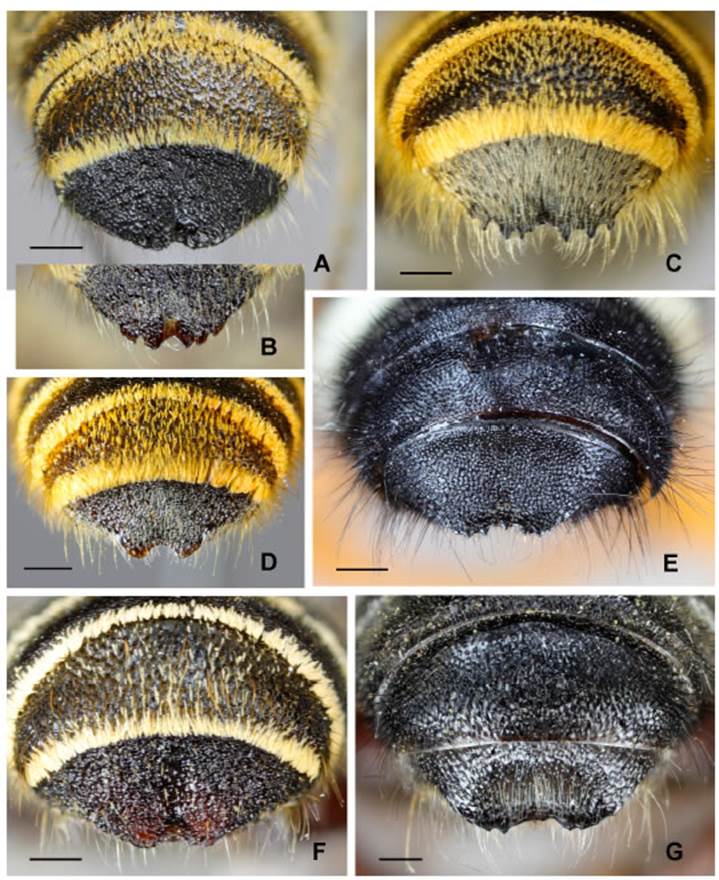
Fig. 11 Megachile (Chrysosarus) species, fifth and sixth metasomal terga, caudal view. A-B. M. platensis new species, showing variation in the shape of the premarginal carina of T6. A. Specimen from Buenos Aires. B. Specimen from Entre Ríos. C. M. sancticlaudii n. sp. D. M. interjecta Vachal. E. M. euzona Pérez. F. M. basimacula n. sp. G. M. tetrazona Friese.
Megachile interjectaVachal, 1909: 6, 16. Holotype male, Buenos Aires [Argentina], 7-II-99. (MNHN, EY35451, examined through photographs).
Diagnosis. Females are readily distinguished by their mandibles, which have the second inter space with a small cutting edge and the third interspace narrow, oblique, and partially closed by a rudimentary cutting edge arising from the lower margin of the fourth tooth (Fig. 1A). The males are distinguished by the color pattern of the pilosity of the face: the upper half to upper one-fourth of the clypeus bears black hairs, in contrast with the white hairs of the rest of the face (Fig. 2C); they are also distinguished by the preapical carina of T6, abruptly produced on the middle one-third of the tergum and distinctly emarginate, thus forming two broad teeth (Fig. 2B, 11D). The outer fringe of the foretarsus is much reduced: on the basitarsus it is restricted to the apical third, and the hairs are approximately as long as the width of the tarsomeres (Fig. 5A).
Female. Body length: 8.8-10.5 mm. Forewing length: 6.7-7.7 mm. Color. Black, except under side of flagellum, tibial spurs, and claws reddish brown. Wings weakly infuscate, darker along costal margin of marginal cell, and on apex of forewing; veins and pterostigma dark brown. Pubescence. Head: white around antennal sock ets, on paraocular areas, posterior margin of ver tex and genae; some specimens with few white hairs on sides of clypeus; other hairs black; some specimens with white hairs reduced on head to upper paraocular areas and above antennal sockets. Mesosoma: white on pronotal collar, pronotal lobes, dense tuft behind pronotal lobe, anteriorly on tegula, on scutum, scutellum and metanotum; other hairs of mesosoma including legs, black; some specimens with white hairs ex tended to entire propodeum and middle and hind legs. Hairs on disc of scutum of various lengths, 0.2-1.2x MOD, longer on mesopleuron (1.5-1.7x MOD). Metasoma: T1 on disc and marginal area with white, long hairs (0.9-1.5x MOD), not form ing definite apical band; T2-T5 with distinct api cal bands (on T2-T3 weaker medially), white to yellowish on T2-T3, yellow on T4-T5; discs of T2-T5 with yellowish erect hairs (on T3 0.3-0.5x MOD); T6 with yellowish appressed pubescence and stiff erect hairs yellowish basally and black apically. Scopa yellow from S2 to apex of S6; S3-S5 with lateral apical yellowish fasciae under scopa. Sculpture. Clypeus and supraclypeal area with dense and irregular punctures separated by shiny interspaces (0.1-0.3x PD), some speci mens with narrow, median impunctate longitu dinal stripe on supraclypeal area. Punctures on scutum nearly coalescent, small, half the size of those of clypeus; punctures of mesopleuron be low hypoepimeral area similar to those of scu tum, but becoming larger ventrally and separat ed by tessellate interspaces 0.2-0.5 PD. Discs of metasomal terga with small punctures separated by 0.3-0.5 PD. Structure. Inner margin of eyes converging below, upper interocular distance 1.08x lower interocular distance. Distance from lateral ocellus to posterior margin of head 1.8x MOD. Maximum width of gena in lateral view 0.7x maximum width of eye. Clypeus 2.2x as wide as long, more convex on upper third; apex den ticulate, with median denticle larger than lateral ones. Mandible with four teeth; first to third teeth of similar size; fourth tooth broad, distinct ly incised; second interspace with small cutting edge; third interspace narrow, oblique, partially closed by rudimentary cutting edge arising from lower margin of fourth tooth (independent of premarginal carina); upper acetabular groove with apical tuft; outer premarginal impressed line with few scattered setae bordering fourth tooth. Hypostomal carina ending close to poster omesal angle of mandibular socket. Proportions of scape, pedicel and first three flagellomeres 3.4:0.9:1:0.7:1; first flagellomere 1.25x as long as its apical width. Hind basitarsus 2.8x as long as its maximum width in lateral view.
Male. Body length 7.8-9.5 mm; length of forew ing 5.7-6.7 mm. Color. Black, except foreleg with underside of femur, underside of tibia, tibial spur and tarsus yellowish brown; underside of second tarsomere with ovoid black spot. Claws of mid and hind legs yellowish brown. Wings as in fe male. Pubescence. Hairs of head mostly white, except black on upper half to upper one-fourth of clypeus, on vertex and around outer orbits. Venter and sides of mesosoma with black hairs, and dorsum with white hairs, except disc of scu tum and scutellum with intermixed black and white hairs. Coxae, femora, and fore and middle tibiae with black hairs, hind tibiae and tarsi with white hairs. Outer fringe of foretarsus of short hairs (1.0-1.4x MOD), on basitarsus restricted to apical third. T1 with white hairs on disc and apically, not forming distinct apical band; T2-T5 with distinct yellow apical bands; discs of T2-T5 with erect, simple, yellowish hairs, disc of T5 also with appressed, plumose, yellow hairs; T6 with erect, simple, pale-yellowish, slender hairs, inconspicuous in caudal view. S2-S3 with apical fringes; hairs on S2 rather sparse, longer laterally, on S3 of even length, very dense medi ally. Sculpture. Punctation similar to that of fe male. T6 densely covered with small, coalescent punctures. Structure. Lower margin of mandible without any angle or projection. Proportions of scape, pedicel and first three flagellomeres 3.6:0.9:1:1.2:1.3; first flagellomere as long as 1.2x its apical width; last flagellomere unmodi fied. Hypostomal area unmodified. Anterior sur face of forecoxa with long, finely branched hairs, and patch of short red bristles partially hidden by plumose hairs; coxal spine short, as long as 1x MOD. Outer margin of foretibia rounded. Forebasitarsus flattened, short, 1.4x as long as its apical width; inner margin with digitiform prolongation. Preapical carina of T6 strongly produced on middle one-third of tergum and me dially emarginate. S5, S6, and S8, as in Figure 6A.
Comments. Vachal (1909) mentions in the de scription of the species the date of collection of the holotype as 7-II-99, but the year (most prob ably 1899) is not written on the label pinned with the specimen (Fig. 2D).
Distribution. Argentina, provinces of Buenos Aires, La Rioja, Mendoza, Salta, San Luis, and Santa Fe. Uruguay, department of Montevideo (Fig. 7A).
Material studied. ARGENTINA. Buenos Aires: 1 M, San Isidro, 11-II-1927, J. Brèthes (MACN); 1 M, Patagones, XI-1937, M.J. Viana (MACN); 1 F, San Miguel, F.C.P., 2-IV-1938, Novoa S.J. (MACN); 1 F, Escobar, Maq. Savio, 6-I-1998, A. Roig A. (MACN); 1 F, Tres Arroyos, Claromecó, Vivero, 27-II-2006, ex Adesmia bicolor [Fabaceae], A. Roig A. (MACN); 2 F, Tornquist, Villa Ventana, 4-5-I-2008, A. Roig A. (MACN); 1 F, Punta Chica, 20-27-III-1950, ex Jussiaea re pens [= Ludwigia pleploides, Onagraceae], M. Senkute (SEMC); 1 M, San Isidro, 20-III-1950, M. Senkeute [sic] (SEMC); 1 F, Delta del Río Paraná, 26-III-1950, M. Senkeute (SEMC); 2 F, Punta Lara, 16-IV-1950, M. Senkute (SEMC); 1 F, Hurlingham, IV-1950, M. Senkute (SEMC); 1 M, San Isidro, XII-1950, E. Plaumann (SEMC); 1 F, Delta de Río Paraná, 6-II-1951, E. Plaumann (SEMC); 2 F, San Fernando, 17-III-1951, J. Foerster (SEMC); 1 F, Punta Lara, 24-III-1951, J. Foerster (SEMC); 2 F, Bolívar, 28-III-1951, J. Foerster (SEMC); 1 F, Fco. Madero, XI-1951, J. Foerster (SEMC); 1 F, González Catán, II-1952, J. Foerster (SEMC); 1 F, Boulogne, 6-IV-1953, M. Senkute (SEMC); 1 F, Hurlingham, III-1954, F.H. Walz (SEMC); 1 F, Luján, III-1954, F.H. Walz (SEMC); 2 M, Villa Elisa, II-1955, J. Foerster (SEMC); 1 F, San Isidro, IV-1960, M. Senkute (SEMC). Ciudad Autónoma de Buenos Aires: 1 F, 25-III-1904, J. Brèthes (MACN); 1 F, 1 M, 4-IV-1904, J. Brèthes (MACN); 3 F, 1 M, 25-III-1909, J. Brèthes (MACN); 1F, 1M, “nidifie dans le panier d’ Oiketicus platensis Berg”, XII-1917, J. Brèthes (MACN); 1 M, 16-II-1920, J. Brèthes (MACN); 1 M, 10-II-1921, J. Brèthes (MACN); 1 F, 3-III-1921, J. Brèthes (MACN); 1 F, 1 M, 2-III-1922, 12286, J. Brèthes (MACN); 1 F, 6642, J. Brèthes (MACN); 1 F, V-1951, J. Foerster (SEMC). La Rioja: 1 M, Anillaco, S 28° 43’ 45.36’’ W 66° 56’ 5.09’’,1-6-XI-2011, ex Prosopis [Fabaceae], A. Roig A., R. Gonzalez-Vaquero & L. Compagnucci (MACN); 1 F, Estación Amado, 21-IX-1922 (MACN). Mendoza: 1 M, Potrerillos, II-1973, A. Roig A. (MACN). Salta: 1 F, 5 km NE of Cafayate, 14-XI-1993, A. Roig A. (MACN). San Luis: 1 M, La Angelina, without date, E. Almandoz (MACN). Santa Fe: 1 F, Esperanza (Potrero), 8-III-2005, M. Dalmazzo (MACN). URUGUAY. Montevideo: 1 F, Montevideo, 25-II-1909, J. Brèthes (MACN).
Megachile (Chrysosarus) sancticlaudii n. sp.
(Figs. 1C, 3A-D, 5C, 6B, 7B, 11C)
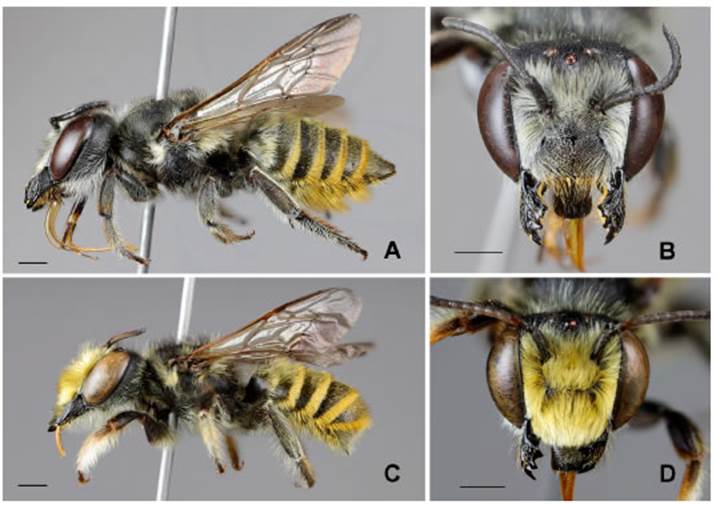
Fig. 3 Megachile sancticlaudii n. sp. A-B. Female holotype. A. Lateral view. B. Face. C-D. Male. C. Lateral view. D. Face. Scale lines = 1 mm.
urn:lsid:zoobank.org:act:7EE5B239-E0DD-4 A9D-A1B7-E836A86E2708
Diagnosis. Females are easily distinguished by the presence of complete apical fasciae below the scopa on S2-S5. Males can be distinguished by the lower margin of the mandible with an acute angle near the apical third, and the carina of T6 with a shallow median emargination and lateral ly with 3-4 irregular spiniform teeth (Fig. 11C).
Female. Body length: 9-12 mm (holotype 11.8 mm). Forewing length: 6.8-8.2 mm (holotype 7.7 mm). Color. Integument black, except claws red dish brown. Wings infuscated, darker along cos tal margin of marginal cell and apex of forewing; pterostigma and veins light brown. Pubescence. White hairs on paraocular area, on apical cor ners of clypeus, around antennal socket, on lower part of frons, and on gena and underside of head; hairs black on disc of clypeus, supracly peal area, upper part of frons, and vertex; some specimens with intermixed white and black hairs on disc of clypeus, supraclypeal area and lower part of frons, and some specimens with black hairs restricted to upper part of frons and ver tex; apical margin of clypeus with tufts of golden hairs. Mesosoma mostly with white hairs, except upper part of mesopleuron with black hairs, and discs of scutum and scutellum either with black hairs or with intermixed black and white hairs. Hairs on disc of scutum erect, of various lengths, 0.4-1.4x MOD, longer on mesopleuron (1.1-1.6x MOD). Foreleg with white hairs on coxa, tro chanter and femur, on remainder of leg mostly orange and white, and orange on under surface of tarsus; mid- and hind- legs with white hairs, except on tarsi intermixed with brown hairs. T1 with long, white hairs on disc, and apically with weakly defined apical band of hairs 0.6-0.9x MOD; T2-T5 with short, yellowish hairs on discs (on T3 0.3-0.4x MOD), and complete apical bands of orange-yellow, plumose hairs, although in some specimens band on T2 medially inter rupted; T6 with yellowish, decumbent hairs and scattered, semierect, longer brown hairs. Scopa orange-yellow on S2-S6. S2-S5 with complete apical fasciae of yellowish white hairs, in some specimens fascia medially interrupted on S2. Sculpture. Clypeus with dense punctures, sepa rated by feebly tessellate to polished interspaces 0.1-0.2x PD (although sparser along midline); supraclypeal area with smaller punctures sepa rated by feebly tessellate interspaces 0.3-0.5x PD. Scutum, scutellum and mesopleuron with dense, uniform punctures separated by tesselate interspaces 0.1-0.3x PD. Structure. Inner margin of eyes converging below, upper interocular dis tance 1.08x lower interocular distance. Distance from lateral ocellus to posterior margin of head 2x MOD. Maximum width of gena in lateral view 0.75x maximum width of eye. Clypeus 2.5x as wide as long; apex denticulate. Mandible with four teeth; first and second teeth of similar size; third tooth bearing a small but distinct cutting edge; fourth tooth broad, incised; second and third interspaces in form of asymmetric V; upper acetabular groove with apical tuft; outer premar ginal impressed line with stiff setae close to fourth tooth. Hypostomal carina ending close to poster omesal angle of mandibular socket. Proportions of scape, pedicel and first three flagellomeres 3.6:0.8:1:0.75:0.85; first flagellomere 1.15x as long as its apical width. Hind basitarsus 3.3x as long as its maximum width in lateral view.
Male. Body length: 7.5-10.5 mm. Forewing length: 6.2-7.5 mm. Color. Black, except on fore leg undersurface of femur and tibia brown, tibial spur and claws brown, and tarsus yellowish (in some specimens distitarsus and proximal part of basitarsus brown, contrasting with yellowish second to fourth tarsomeres); second tarsomere of foretarsus with a black, ellipsoid macula on undersurface. Wings as in female. Pubescence. Yellow on face, black on vertex and white on gena and underside of head. Hairs black intermixed with some white hairs on scutum and scutel lum; hairs brown on lateral side of pronotum, on upper part of mesopleuron and on lateral and posterior sides of propodeum; other hairs of me sosoma white. Legs with white hairs intermixed with sparse black hairs. Outer fringe of foretar sus white, with hairs 1.2-1.6x apical width of basitarsus. Metasoma with yellow hairs, those of discs longer on T1 and T5 than on T2-T4; T6 with abundant decumbent hairs and sparse erect ones. Apical bands of golden-yellow hairs forming lateral patch on T1, complete on T2-T5, although narrowed on T2-T3 and in some speci mens briefly interrupted medially. Sterna with yellow hairs on discs and complete, dense api cal fringes of plumose hairs on S2-S4; hairs of fringes long laterally (1-1.5x MOD) and shorter medially (0.2-0.5x MOD). Sculpture. Similar to that of female. T6 entirely covered with min ute, nearly coalescent punctures, usually hidden by the pubescence. Structure. Lower margin of mandible on apical third with distinct angle bear ing sharp point. Apical margin of clypeus with irregular denticles. Proportions of scape, pedi cel and first three flagellomeres 3:0.8:1:1.2:1.3; first flagellomere 1.3x as long as its apical width; last flagellomere weakly broadened. Hypostomal area unmodified. Anterior surface of forecoxa with long, finely branched hairs hiding patch of pale-reddish, stiff bristles; forecoxal spine pres ent, strong, 1.0x MOD. Outer margin of foretibia not carinate. Forebasitarsus rather cylindrical, 3.5x as long as its apical width. Preapical carina of T6 medially with small emargination and lat erally with 3-4 irregular spiniform teeth. S5, S6, and S8, as in Figure 6B.
Comments. All specimens from the type locality have been reared from trap-nests.
Etymology. The species name is taken from the San Claudio Farm, type locality, at department of Carlos Casares in the province of Buenos Aires.
Distribution. Argentina, provinces of Buenos Aires, Formosa, and Misiones (Fig. 7B).
Material studied. Holotype: MACN-En 39922, female, Argentina, Buenos Aires, Carlos Casares, Ea. San Claudio, date of emergence 30-IV-2015, J.P. Torretta (MACN).
Following paratypes: ARGENTINA. Buenos Aires: 1 M, Moreno, La Reja, Parque Muñiz, 3-XII-2003, ex duraznillo [= Cestrum sp.; Solanaceae], L. Compagnucci (MACN); 1 F, Rojas, Ea. Las Polvaredas, 21-I-2011, V. Le Féon, C Bertrand & G. Molina (MACN); 10 F, Pdo. Tigre, Delta, 1a sección Río Carapachay, 12-III-2015, A. Roig A. (MACN); 40 M, 40 F, Carlos Casares, Ea. San Claudio, from trap-nests with different dates of emergence: from 28-XII-2014 to 18-XI-2015 and from 28-XII-2015 - 28-XI-2016, J.P. Torretta (FAUBA and MACN). Ciudad Autónoma de Buenos Aires: 1 M, 1 F, Palermo, “habitant du ceibo”, J. Brèthes (MACN); 1 F, 25-III-1904, J. Brèthes (MACN); 1 F, 27-III-1904, J. Brèthes (MACN); 2 M, 4-IV-1904, J. Brèthes (MACN). Formosa: 1 F, Formosa, Reserva Laguna Oca, 26-IX/-4-X-2008, G. Galvani (MACN); 1 M, Formosa, Reserva Laguna Oca, 26-IX/-4-X-2008, in yellow pan-trap, G. Galvani (MACN). Misiones: Iguazú, P.N. Iguazú, 25° 40’ S, 54° 27’ W, 5-IX-2008, A. Taylor & N. Veiga (MACN).
Megachile (Chrysosarus) platensis n. sp.
(Figs. 1B, 4A-D, 5B, 6C, 7C, 11A-B)
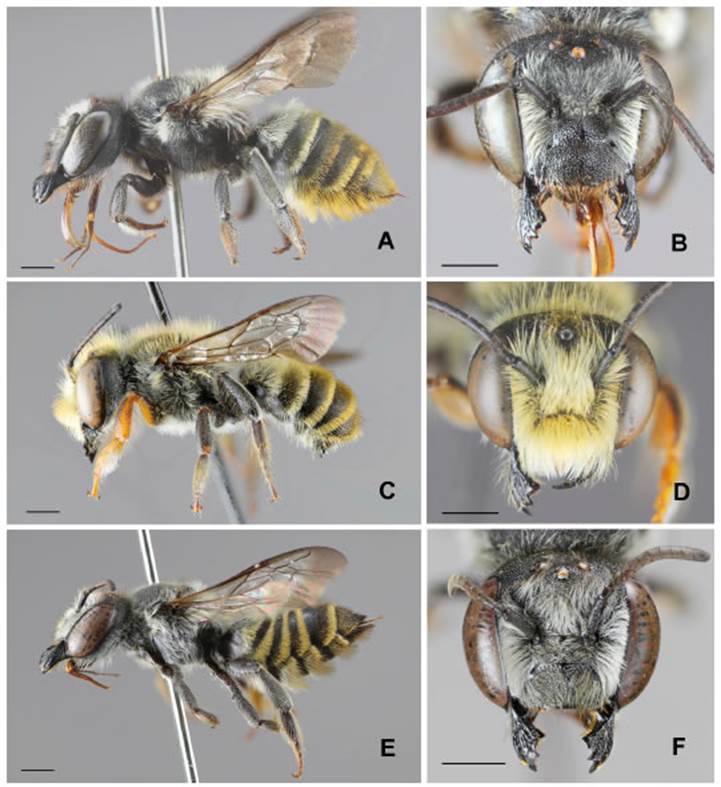
Fig. 4 A-D. Megachile platensis n. sp. A-B. Female holotype. A. Lateral view. B. Face. C-D. Male. C. Lateral view. D. Face. E-F. Megachile simpliciclypeata n. sp., female holotype. E. Lateral view. F. Face. Scale lines = 1 mm.
urn:lsid:zoobank.org:act:D13E01A2-7D5E-45 BD-9B7E-BF8FFB2FBB7C
Diagnosis. Females are recognized, among those species with lateral apical fasciae under the scopa and an incised upper tooth in the man dible, by the entirely black pilosity of the clypeus and supraclypeal area (Figs. 4A-B), the absence of scuto-scutellar band, and the long hairs on T1, not forming a definite apical band (Fig. 4A). Males are distinguished by the lower margin of the mandible without any angle or projection, but with a basal tuft of hairs, by the short ante rior basitarsus, the tuberculate first metasomal sternum, and the lack of appressed pubescence on T6.
Female. Body length: 7.5-10.8 mm (holotype, 10.6 mm). Forewing length: 5.5-7.5 mm (ho lotype, 6.6 mm). Color. Black, except reddish brown claws. Wings weakly infuscate; veins and pterostigma dark brown. Pubescence. Head: black on clypeus, supraclypeal area, and vertex; white along inner margin of eyes; on other ar eas of head white with intermixed black hairs. Mesosoma: white behind pronotal lobe, sides of metanotum, and above propodeal spiracle; some specimens with white hairs on anterior and lat eral margins of scutum; other areas of mesosoma with variable amounts of intermixed white and black hairs: mostly white on scutellum, metano tum, and posterior surface of propodeum, and mostly black on sides and venter of mesosoma; without scuto-scutellar band. Pubescence of legs mostly white. Scutum with erect short hairs (0.3-0.5x MOD), and interspersed longer ones (0.7-1.3x MOD). Scutellum and metanotum with very long hairs, up to 3.2x MOD. Mesopleuron densely covered with hairs 1.5-2.0x MOD. T1 with long white hairs, on marginal area 1.0-1.2x MOD, not forming definite apical band. T2-T5 with distinct apical bands, yellowish on T2-T3, yellow on T4-T5; discs of T2-T5 with yellow erect hairs (on T3 0.7-1.2x MOD); T6 with yellow appressed pubes cence and stiff erect yellow hairs. Scopa yellow from S2 to apex of S6; S2-S5 with short lateral apical whitish fasciae under scopa; on S3 fasci ae occupying lateral 0.2-0.3 of apical margin of sternum; in some specimens, fasciae on S2 much reduced. Sculpture. Clypeus with dense, regular punctures separated by shiny interspaces (0.2-0.3x PD), punctures medially not reaching mar gin, leaving apical polished band; supraclypeal area with similar punctures and narrow, median tessellate longitudinal stripe without punctures. Punctures on scutum small, nearly coalescent; punctures of mesopleuron small and dense, similar to those of scutum. Discs of metasomal terga with small punctures separated by 0.3-0.5 PD. Structure. Inner margin of eyes converging below, upper interocular distance 1.15x lower in terocular distance. Distance from lateral ocellus to posterior margin of head 1.6x MOD. Maximum width of gena in lateral view 0.53x maximum width of eye. Clypeus 2.2x as wide as long; apex denticulate (in some specimens denticles weaker medially). Mandible with four teeth; first to third teeth of similar size; third tooth with rudiment of cutting edge; fourth tooth broad, distinctly in cised; upper acetabular groove with apical tuft; outer premarginal impressed line with few scat tered setae bordering fourth tooth. Hypostomal carina ending close to posteromesal angle of mandibular socket. Proportions of scape, pedicel and first three flagellomeres 3.3:0.9:1:0.8:0.9; first flagellomere 1.28x as long as its apical width. Hind basitarsus 2.6x as long as its maxi mum width in lateral view.
Male. Body length 8.0-10.2 mm; length of fore wing 5.2-7.2 mm. Color. Black, except foreleg with underside of femur, most of tibia, tibial spur and tarsus yellowish brown; underside of second tar somere with ovoid black spot. Claws of mid and hind legs yellowish brown. Wings as in female. Pubescence. Hairs of head yellowish to yellow on face and vertex, white on genae and underside of head. Lower margin of mandible with basal tuft of hairs. Dorsum of mesosoma with yellowish to yellow hairs; venter and sides of mesosoma with white hairs. Legs with whitish hairs; fringes of fore and middle basitarsi white. Outer fringe of foretarsus of short hairs, on basitarsus 1.0-1.4x MOD, longer basally, on second tarsomere 0.7-0.9x MOD. T1 with yellowish hairs on disc and apically, not forming distinct apical band; T2-T5 with distinct yellow apical bands and their discs with erect, simple, yellow hairs; disc of T5 also with appressed, plumose, yellow hairs, at least basally; T6 with erect, simple, yellowish, slender hairs, and without appressed pubescence on the disc, but small patch of appressed pubescence may be present laterally close to the gradulus. S2-S4 with apical fringes; hairs on S2 longer lat erally, 1.2-1.4x MOD. Sculpture. Punctation sim ilar to that of female. T6 with small, coalescent punctures forming rugulose sculpture. Structure. Lower margin of mandible without any angle or projection. Proportions of scape, pedicel and first three flagellomeres 3.5:0.75:1:1.15:1.25; first flagellomere as long as 1.15x its apical width; last flagellomere broadened. Hypostomal area unmodified. Anterior surface of forecoxa with few, short hairs, and patch of red bristles close to coxal spine reduced to 4-5 minute bristles to ab sent; coxal spine short, as long as 1x MOD. Outer margin of foretibia rounded. Forebasitarsus flat tened, short, 1.2x as long as its apical width; inner margin with digitiform prolongation. Preapical carina of T6 with small median emargination, and lateral to it irregularly rounded, crenulate, to distinctly crestate. S1 bearing a median tubercle pointing caudally. S5, S6, and S8, as in Figure 6C.
Comments. The preapical carina of T6 of the male varies from nearly even at both sides of the small median emargination (Fig. 11A) to crenulate, and to distinctly dentate (Fig. 11B). The male specimen studied from Entre Ríos has more extensive yellow appressed pubescence on T5 than specimens studied from elsewhere.
Etymology. The species name refers to the pres ence of the species on both margins of the Río de la Plata.
Distribution. Argentina, provinces of Buenos Aires, Corrientes, and Entre Ríos. Uruguay, de partment of Cerro Largo (Fig. 7C).
Material studied. Holotype: MACN-En 39923, female, Argentina, Capital Federal, Reserva Ecológica Costanera Sur [-34.6092, -58.3511], 24-III-2004, A. Roig A. & L. Compagnucci (MACN). Following paratypes: Argentina. Buenos Aires: 1 F, Hurlingham, INTA Castelar, Jardín Botánico, 6-XI-2003, A. Roig Alsina & L. Compagnucci, (MACN); 1 F, Pdo. Tandil, Tandil, Las Dinas, S 37° 22’ 02’’ W 59° 07’ 54’’, 24-25-II-2011, en vuelo frente a barranca, C. Roig (MACN); 2 F, Pdo. Tandil, Tandil, Las Dinas, S 37° 22’ 02’’ W 59° 07’ 54’’, 24-II-2011, Clara Roig (MACN); 1 F, Tandil, Tandil, Las Dinas, 9-10-III-2011, C. Roig & A. Roig A. (MACN); 1 F, Pdo. Tres Arroyos, Claromecó, Vivero, 27-II-2006, ex Salpichroa [Solanaceae], A. Roig A. (MACN); 3 F, Tres Arroyos, Claromecó, 27-II-2006, A. Roig Alsina (MACN); 1 F, Tornquist, pie Cerro Ventana, 18-I-1994, A. Roig Alsina, (MACN); 1 F, Tornquist, Villa Ventana, 4/5-I-2008, A. Roig Alsina (MACN); 1 F, Malvinas Argentinas, Km 26 F.C.G.B., XII-1989, O. Di Iorio (MACN); 1 F, Tigre, 12 km NO Tigre, 17-XI-2005, Compagnucci & Roig Alsina (MACN); 2 F, Moreno, La Reja, Reserva F.J. Muñiz, 3-XII-2003, L. Compagnucci (MACN); 1 F, Moreno, La Reja, Reserva F.J. Muñiz, 2-XI-2003, L. Compagnucci (MACN); 1 M, Moreno, La Reja, Parque Muñiz, 22-XI-2002, Roig Alsina & Compagnucci (MACN); 1 M, 3 F, Moreno, La Reja, Parque Muñiz, 15-XII-2016, A. Roig A. (MACN); 1 F, Moreno, La Reja, Reserva F.J. Muñiz, 1-XII-2017, R. Ferrer (MACN); 1 M, Azul, Sierras R.P. 80, -37.06, -58.76, XI-2013, A. Sanguinetti, (MACN); 20 M, 20 F, Carlos Casares, Ea. San Claudio, from trap-nests with different dates of emergence: from 30-XII-2014 to 18-XI-2015 and from 8-I-2016 to 23-XI-2016 (FAUBA and MACN);1 M, 1 F, Tornquist, 18 December 2022 (date of emergence from trap-nest), J. Haedo & H. Marrero (FAUBA). Corrientes: 1 F, Santa Teresa, P. N. Mburucuyá (28°01.233 S, 58°02.367 W), 5-X-2009, N. Veiga (MACN); 1 F, Santa Teresa, P. N. Mburucuyá, 17-X-2008, A. Taylor & N. Veiga (MACN); 1 F, P. N. Mburucuyá, Potrero 5, 17-X-2008, A. Taylor & N. Veiga (MACN). Entre Ríos: 1F, 1 M, Federación, I-1997, G. Zubarán (MACN). Uruguay. Cerro Largo: 1 F, Cuchilla de Melo, 13-XI-1916 (MACN).
Megachile (Chrysosarus) simpliciclypeata n. sp.
(Figs. 4E-F, 7D)
urn:lsid:zoobank.org:act:AE8FD599-A1D9-446 D-9404-332959BFF135
Diagnosis. Females are characterized by the edentate, arched apex of the clypeus (Fig. 4F), without the usual denticles present in most oth er species of Chrysosarus. Also characteristic is the roundish shape of the head, with an arched vertex and the anterior ocellus slightly above the upper ocular tangent (Fig. 4F).
Female. Body length: 8.0-9.5 mm (holotype, 9.2 mm). Forewing length: 5.8-6.3 mm (holotype, 6.0 mm). Color. Black, except under side of flagel lum, tibial spurs, and claws reddish brown. Wings weakly infuscate; veins and pterostigma dark brown. Pubescence. Head: white, except brown long hairs on vertex. Mesosoma: white, except intermixed long brown hairs on posterior half of scutum and on scutellum; legs with white hairs. Hairs on disc of scutum of various lengths, 0.2-0.8x MOD, brown hairs on posterior part longer, up to 2x MOD; hairs on mesopleuron 0.9-1.2x MOD. T1 on disc and marginal area with whitish, long hairs (0.8-1.2x MOD), not forming definite apical band; T2-T5 with distinct apical bands, yellowish on T2-T3, yellow on T4-T5; discs of T2-T5 with short, brown to black erect hairs (on T3 0.3-0.6x MOD); T6 with yellowish appressed pubescence and stiff, black erect hairs. Scopa yellowish from S2 to apex of S6; S2-S5 with lateral apical whitish fasciae under scopa; on S3 fasciae occupying lat eral 0.5 of apical margin of sternum. Sculpture. Clypeus with deep, regular punctures separated by shiny interspaces (0.2-0.4x PD), punctures medially not reaching margin, leaving apical pol ished band; supraclypeal area with dense punc tures half the size of those of clypeus. Punctures on scutum nearly coalescent, smaller than those of supraclypeal area; punctures of mesopleuron similar in size to those of clypeus, separated by shiny interspaces 0.2-0.5 PD. Discs of meta somal terga with small punctures separated by 0.2-1.0 PD. Structure. Inner margin of eyes con verging below, upper interocular distance 1.18x lower interocular distance. Distance from lateral ocellus to posterior margin of head 1.9x MOD. Maximum width of gena in lateral view 0.57x maximum width of eye. Clypeus 2.15x as wide as long; apex with edentate median polished band. Mandible with four teeth; first to third teeth of similar size; third tooth with rudiment of cut ting edge; fourth tooth broad, distinctly incised; upper acetabular groove with apical tuft; outer premarginal impressed line with few scattered setae bordering fourth tooth. Hypostomal carina ending close to posteromesal angle of mandibu lar socket. Proportions of scape, pedicel and first three flagellomeres 3.8:1:1:0.8:1; first flagellom ere as long as its apical width. Hind basitarsus 2.9x as long as its maximum width in lateral view.
Male. Unknown.
Etymology. The species name refers to the sim ple apical margin of the clypeus of the female.
Distribution. Argentina, provinces of Chaco, Corrientes, and Misiones (Fig. 7D).
Material studied. Holotype: MACN-En 39924, female, Argentina, Misiones, INTA Cerro Azul, 17-X-2010, Roig Alsina et al. (MACN).
Following paratypes: Argentina. Chaco: 1 F, Colonia Popular, 12-XI-2017, A. Schaller (MACN); 1 F, Capitán Solari, P.N. Chaco, S 26° 53.493’ W 59° 36.561’, 21-II-2008, A. Taylor & N. Veiga (MACN). Corrientes: 2 F, PN Mburucuyá, S 28° 01’ W 58° 02’, 3-X-2008 and 17-X-2008, A. Taylor & N. Veiga (MACN); 3 F, PN Mburucuyá, Santa Teresa, S 28° 01.183’ W 58° 02.150’, 5-X-2009, MT, N. Veiga (MACN); 3 F, PN Mburucuyá, Tung, 15-III-2010, 9-IV-2010, and 10-X-2010, Malaise trap, N. Veiga (MACN). Misiones: 3 F, INTA Cerro Azul, 17-X-2010, A. Roig A. et al. (MACN).
Megachile (Chrysosarus) basimacula n. sp.
(Figs. 1D, 8C-F, 10A, 11F, 12A, 13A)
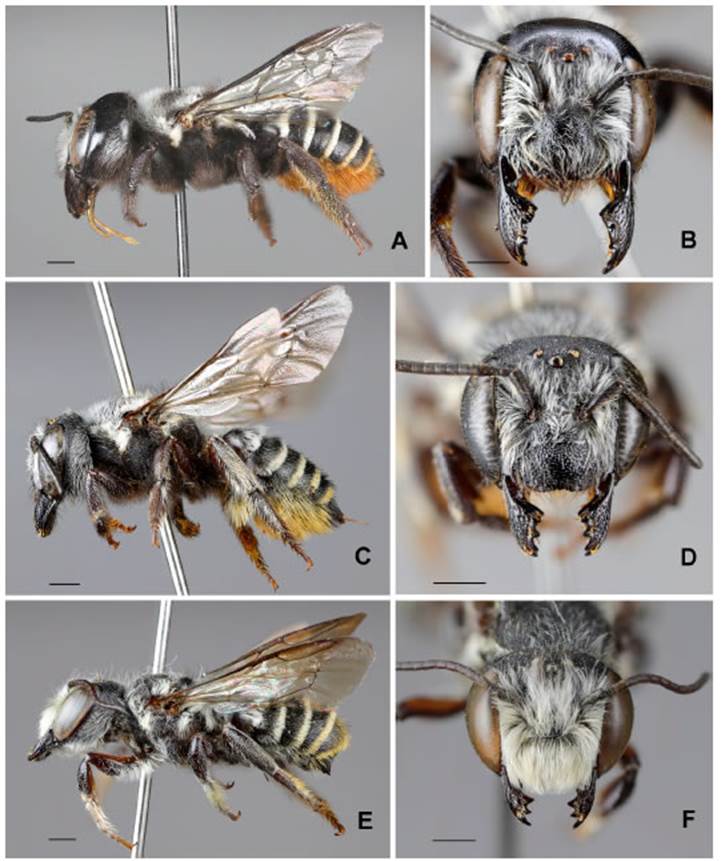
Fig. 8 A-B. Megachile cubiceps Friese, female. A. Lateral view. B. Face. C-F. M. basimacula n. sp. C. Female holotype, lateral view. D. Female holotype, face. E. Male, lateral view. F. Male, face. Scale lines = 1 mm.
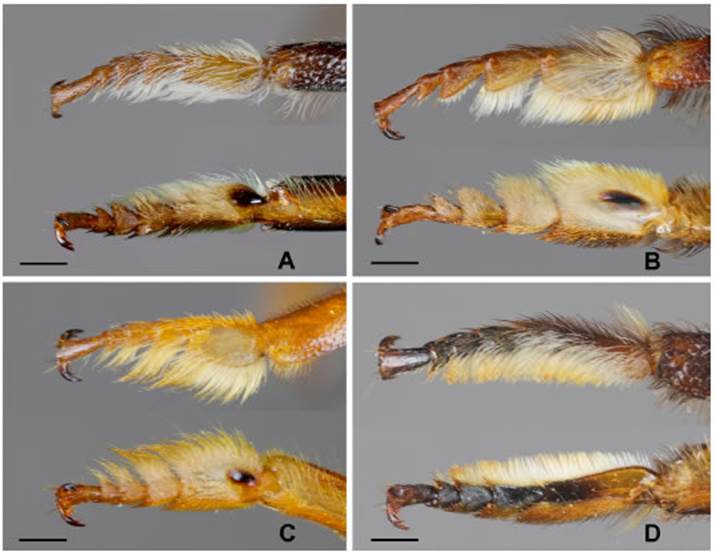
Fig. 10 Megachile (Chrysosarus) species, anterior tarsus of male, dorsal (above) and ventral (below) views. A. M. basimacula n. sp. B. M. cubiceps Friese. C. M. euzona Pérez. D. M. tetrazona Friese. Scale lines = 0.5 mm.
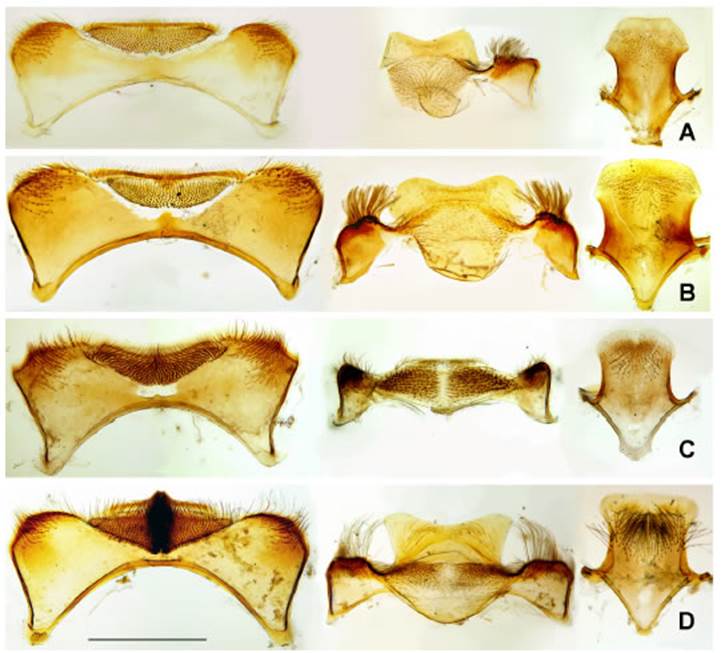
Fig. 12 Metasomal sterna of Megachile (Chrysosarus) males: S5 (left), S6 (center), and S8 (right). A. M. basimacula n. sp. B. M. cubiceps Friese. C. M. euzona Pérez. D. M. tetrazona Friese. Scale line = 1 mm.
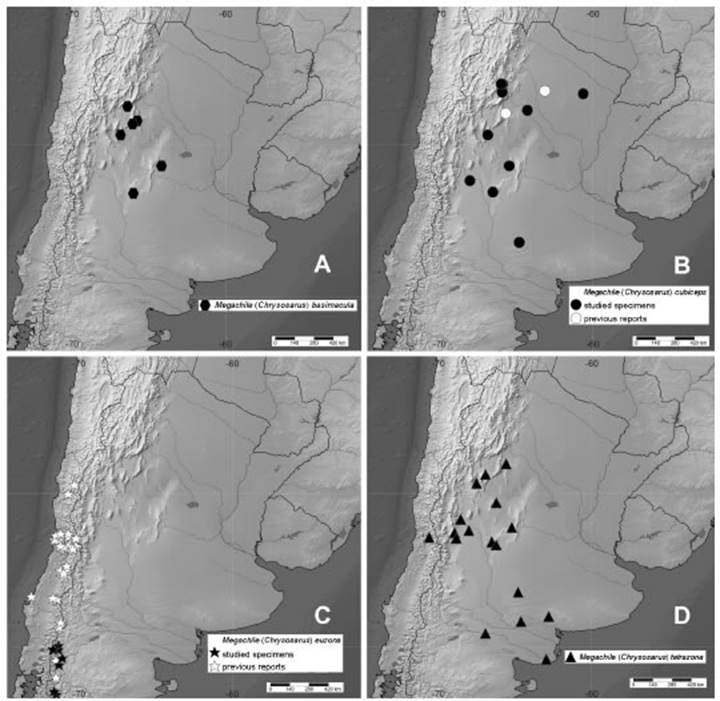
Fig. 13 Distribution maps of Megachile (Chrysosarus) species. A. M. basimacula n. sp. B. M. cubiceps Friese. C. M. euzona Pérez. D. M. tetrazona Friese. Previous reports for M. cubiceps are from Gonzalez et al. (2018), and those for M. euzona from GBIF.org (2023).
urn:lsid:zoobank.org:act: EDE28B78-344D-4E31-8F77-DE13A1981814
Diagnosis. The female is distinguished by the presence of a small cutting edge in the second interspace of the mandible (Fig. 1D), and by its clypeus, gibbous basally and flattened on the api cal third, with a broad apical polished band (Fig. 8D). The male is morphologically similar to the male of M. cubiceps, but lacks the hypostomal tooth, the anterior basitarsus is more slender, and has extended white pubescence.
Female. Body length: 9.0-11.5 mm (holotype, 10.7 mm). Forewing length: 6.8-8.7 mm (ho lotype, 8.4 mm). Color. Black, except anterior tibial spur and claws reddish brown. Wings weakly infuscate, darker along costal margin of marginal cell; veins and pterostigma dark brown. Pubescence. White around antennal sockets, on paraocular areas, posterior margin of vertex and genae; some specimens with white hairs on sides of clypeus; other hairs of head black. Mesosoma with white hairs on pronotal collar, pronotal lobes, dense tuft behind pronotal lobe, anteri orly on tegula, dense tuft on propodeum above spiraculum, on scutum, scutellum, metanotum, and posterior surface of propodeum; on discs of scutum and scutellum with intermixed white and black hairs; other hairs of mesosoma black; outer surface of tibiae and of hind basitarsus mostly with white hairs. Hairs on disc of scutum of vari ous lengths, 0.3-1.3x MOD, longer on mesopleu ron (up to 1.6x MOD). T1-T5 with distinct white apical bands; disc of T1 with white hairs; discs of T2-T5 with black hairs (on T3 0.3-0.8x MOD); T6 with pale appressed pubescence and stiff erect black hairs. Scopa pale yellowish on S2-S5, black on S6; sterna without apical fasciae under scopa. Sculpture. Clypeus and supraclypeal area with deep punctures separated by polished inter spaces; punctures medially separated by 0.5-1.0 PD, closer laterally; with polished, impunctate apical rim. Punctures on scutum of different siz es, sparser on disc, separated by feebly tessellate interspaces 0.2 1.0 PD; punctures of mesopleu ron below hypoepimeral area similar to those of scutum, sparser ventrally, separated by tessellate interspaces 0.2-0.5 PD. Discs of metasomal terga with small punctures separated by 0.5-1.5 PD. Structure. Inner margin of eyes slightly diverging below, upper interocular distance 0.96x lower in terocular distance. Distance from lateral ocellus to posterior margin of head 1.7x MOD. Maximum width of gena in lateral view 0.9x maximum width of eye. Clypeus 2.2x as wide as long, more convex on upper third and flattened apically; api cal margin denticulate. Mandible with four teeth; first to third teeth of similar size; fourth tooth broad, distinctly incised; second interspace with small cutting edge; third interspace U-shaped; upper acetabular groove with apical tuft; outer premarginal impressed line with stiff setae on all its length. Hypostomal carina curving towards cranial acetabulum and forming thickened strip bordering mandibular socket. Proportions of scape, pedicel and first three flagellomeres 3.6:0.9:1:0.8:1; first flagellomere 1.05x as long as its apical width. Hind basitarsus 3.3x as long as its maximum width in lateral view.
Male. Body length 9.2-10.5 mm; length of fore wing 6.5-8.2 mm. Color. Black, except foreleg with underside of femur, underside of tibia, apex of tibia, tibial spur and tarsus yellowish brown; distitarsi and claws of mid and hind legs red dish brown. Under surface of forebasitarsus with basal ovoid black spot. Wings as in female. Pubescence. White on head, mesosoma, and legs, except vertex of head and discs of scutum and scutellum with intermixed black and white hairs. Outer fringe of foretarsus of short hairs (0.8-1.2x MOD), shorter than maximum width of basitar sus.T1 with white hairs on disc and apically, not forming distinct apical band; T2-T5 with distinct apical bands, white on T2-T3, yellowish on T4-T5; disc of T2 with white hairs; discs of T3-T4 with intermixed white and black hairs and T4 also with some stiff, long yellow hairs preapically; T5 with stiff, long yellow hairs (0.8-2.0x MOD); T6 without appressed pubescence, with sparse, in conspicuous erect hairs; metasomal sterna with white hairs. S2-S3 with apical fringes of plumose hairs, longer and denser laterally (laterally on S2 1.2-1.5x MOD). Sculpture. Punctation similar to that of female. T6 rugose due to coalescent ir regular punctures. Structure. Lower margin of mandible more or less straight, without any angle or projection. Proportions of scape, pedi cel and first three flagellomeres 3.4:1:1:1.4:1.6; first flagellomere as long as 0.9x its apical width; last flagellomere slightly broadened. Hypostomal area unmodified. Anterior surface of forecoxa with sparse, minute hairs, and patch of 16-20 red bristles in front of coxal spine (length of spine 1x MOD). Outer margin of foretibia sharply carinate. Forebasitarsus flattened, widest sub basally, with sinuous outer margin, 2.7x as long as its apical width. Preapical carina of T6 medi ally emarginate and irregularly crenulate later ally; in some specimens median emargination obscured by median crenulations. S5, S6, and S8, as in Figure 12A.
Etymology. The species name refers to the basal black spot on the undersurface of the male basi tarsus.
Distribution. Argentina, provinces of Catamarca, Córdoba, La Rioja, and San Luis (Fig. 13A).
Material studied. Holotype: MACN-En 39925, female, Argentina, Catamarca, San Fernando, 16-XI-1993, A. Roig A. (MACN). Following paratypes: Argentina. Catamarca: 1 F, Catamarca Capital, Choya, 12-IV-1936 (MACN); 1 M, Concepción, 1-II-1928, M. Gómez (MACN). Córdoba: 1 F, Córdoba, E. Giacomelli, no date (MACN). La Rioja: 5 F, 2 M (MACN). San Luis: 1 F, 1 M, Potrero de Los Funes, I-1926, M. Gómez (MACN).
Megachile (Chrysosarus) cubiceps Friese
(Figs. 1E, 8A-B, 10B, 12B, 13B)
Megachile cubicepsFriese, 1906: 97-98. Holotype fe male, Salta, N.-Argentina, Steinbach leg. (ZMB, examined through photographs).
Megachile (Zonomegachile) uncinata González, Griswold & Engel 2018: 60-63, figs. 21, 33 A-E, 34 A-I. Holotype male, 15 km S Colpes, Catamarca, Argentina, 27-X-1972, G.E. Bohart, Zuccagnia punctata. (USDA-ARS Bee Biology and Systematic Laboratory, Logan, Utah, not examined). New synonym.
Diagnosis. This species is one of the largest Megachile in Argentina, with females reaching up to 17 mm long. Females are easily distinguished by their enormous head (Figs. 8A-B), with swol len genae and vertex (distance between lateral ocellus and occipital margin 4.5-6.0x MOD), and by the bright orange scopa with capitate hairs (Fig. 8A). Males can be recognized by the pres ence of a hypostomal tooth, strongly curved and posteriorly directed. Both sexes have the meso soma with black hairs on the sides and venter, and complete white apical bands on T1-T5.
Female. Body length: 10.5-17.0 mm. Forewing length: 7.5-10.7 mm. Color. Integument black, except distitarsi and claws reddish brown, an terior tibial spur yellow, and mid- and hind tib ial spurs brown. Wing infuscated, darker along costal margin of marginal cell; pterostigma brown; veins brown, clearer to apex of forewing. Pubescence. Head with intermixed white and black hairs on most of face, but paraocular ar eas with white hairs; upper three fourths of gena with white hairs, lower fourth and hypostomal area with black hairs; vertex with sparse black hairs. Scutum and scutellum with white hairs on margins, encircling central area with sparse, longer, intermixed black and white hairs; prono tal lobe and anteriorly on tegula with white tuft; metanotum with white hairs; propodeum with white hairs bordering metapostnotum and above spiraculum; other hairs of mesosoma black. Legs with black hairs, except hind tibia with yellow hairs in part, and tarsi with intermixed yellow and black hairs (hind tarsus with some hairs capitate). Disc of scutum with black hairs 0.5-1.3x MOD, and shorter white hairs 0.3-0.7x MOD; hairs longer on scutellum (0.7-2x MOD), mesop leuron (1.2-2.5x MOD) and metanotum (1.5-3x MOD). Metasoma. Anterior surface of T1 with sparse, white hairs, disc of T1 with erect, white hairs (1.1-2x MOD), discs of T2-T6 with black hairs, on T2-T4 short (0.2-0.4x MOD) and longer on T5-T6 (0.5-1.1x MOD). T4-T5 with some or ange hairs laterally anterior to apical bands. T6 with decumbent, plumose whitish hairs and stiff, erect hairs black medially and orange laterally. Apical bands complete on T1-T5, white on T1-T2, with yellowish tint on T3-T4 and yellowish on T5. S1 and basal half of S2 with black hairs. Scopa from apex of S2 to S5 with long, capitate, orange hairs; S6 with shorter orange and black hairs. Sculpture. Clypeus and supraclyeal area with dense and irregular punctures separated by shiny interspaces (0.1- 0.5x PD); in some specimens upper half of supraclypeal area tes sellate. Apex of clypeus with transverse, impunc tate band. Vertex and gena with smaller punc tures, separated by shiny interspaces (1.0-1.5x PD). Acetabular interspace of mandible shiny. 243 Roig-Alsina & Torretta: Bees of the subgenus Megachile (Chrysosarus)
Punctures on most of scutum dense, but on cent er of disc sparse, separated by feebly tessellate to shiny interspaces (0.5-1.5x PD). Punctures on mesopleuron dense, nearly coalescent. Disc of terga with shallow punctures separated by feebly tessellate to shiny interspaces (0.5-2x PD), coars er and denser on T5-T6; on T6 obscured by to mentose pubescence. Structure. Inner margin of eyes slightly diverging below, upper interocular distance 0.9x lower interocular distance. Distance from lateral ocellus to posterior margin of head 4.5-6.0x MOD. Maximum width of gena in lateral view 1.4-2.2x maximum width of eye. Clypeus 3.5-4.0x as wide as long, more convex on upper third and flattened apically; apical margin denticulate, but in many specimens median portion of margin irregular. Mandible with four teeth; first tooth larger than second; fourth tooth broad, truncate, not incised; second interspace asymmetrically V-shaped, with small cutting edge; third inter space oblique; upper acetabular groove with api cal tuft; outer premarginal impressed line with stiff setae on all its length. Hypostomal carina curving towards cranial acetabulum and forming thickened strip bordering mandibular socket. Proportions of scape, pedicel and first three flag ellomeres 3.5:0.7:1:0.9:1; first flagellomere 1.15x as long as its apical width. Hind basitarsus 3.0x as long as its maximum width in lateral view.
Male. The male of this species was described and illustrated in detail by Gonzalez et al. (2018). For ease of comparison, images of S5, S6, and S8 are also included in the present contribution (Fig. 12B).
Comments. The presence of a hypostomal tooth in the male misled Gonzalez et al. (2018) to in clude this species in the subgenus Zonomegachile, although they cautioned that the species might belong to a different subgenus, given that the genital capsule and the hidden sterna differed from those of the other species included in Zonomegachile. The hypostomal tooth is curved and directed backwards in M. cubiceps, while in species of Zonomegachile the tooth is straight and directed forwards.
Distribution. Argentina, provinces of Catamarca, Chaco, Córdoba, La Pampa, La Rioja, Mendoza, Salta, San Luis, Santiago del Estero, and Tucumán (Fig. 13B).
Material studied. Argentina. Chaco: 1 M, Roque Sáenz Peña, 1932, Ohnmeiser (MACN). Córdoba: 1 F, Chancaní, V-1987, “polinizador de Prosopis” [Fabaceae], J. Genise (MACN); 2 F, 2 M, Chancaní, X-1991, J. Genise, J. Farina & P. Hazeldine (MACN). La Pampa: 1 F, Toay, Ea. Anquilòo, 10 December 2010, ex Carduus acan thoides [Asteraceae], H.J. Marrero (FAUBA); 2 M, Toay, Ea. Anquilòo, 10 December 2010, ex Clematis montevidensis [Ranunculaceae], J.P. Torretta (FAUBA); 3 M, Toay, Ea. Anquilòo, 11 December 2010, ex Gaillardia megapotamica [Asteraceae], J.P. Torretta (FAUBA); 4 M, 1 F, Toay, Ea. Anquilòo, 10 December 2010, ex Hyalis argentea [Asteraceae], J.P. Torretta (FAUBA). La Rioja: 1 M, La Rioja (MACN). Mendoza: 2 F, Lavalle, Reserva Telteca, S 32° 25’ 35.3’’ W 67° 55’ 50.3’’, ex Prosopis flexuosa [Fabaceae], G. Debandi (IADIZA). Salta: 1 M, Cafayate, 14-XI-1993, A. Roig A. (MACN); 6 M, Cafayate, Los Médanos, 3-XI-2004, ex Propsopis [Fabaceae], L. Compagnucci & C. Grismado (MACN). San Luis: 6 M, San Jerónimo, XI-1972, G.J. Williner (MACN). Santiago del Estero: 1 F, without fur ther data (MACN). Tucumán: 5 F, 6 M, Amaicha del Valle, 2-XI-2004, ex Propsopis [Fabaceae], L. Compagnucci & C. Grismado (MACN).
Megachile (Chrysosarus) euzona Pérez
(Figs. 9A-B, 10C, 11E, 12C, 13C)
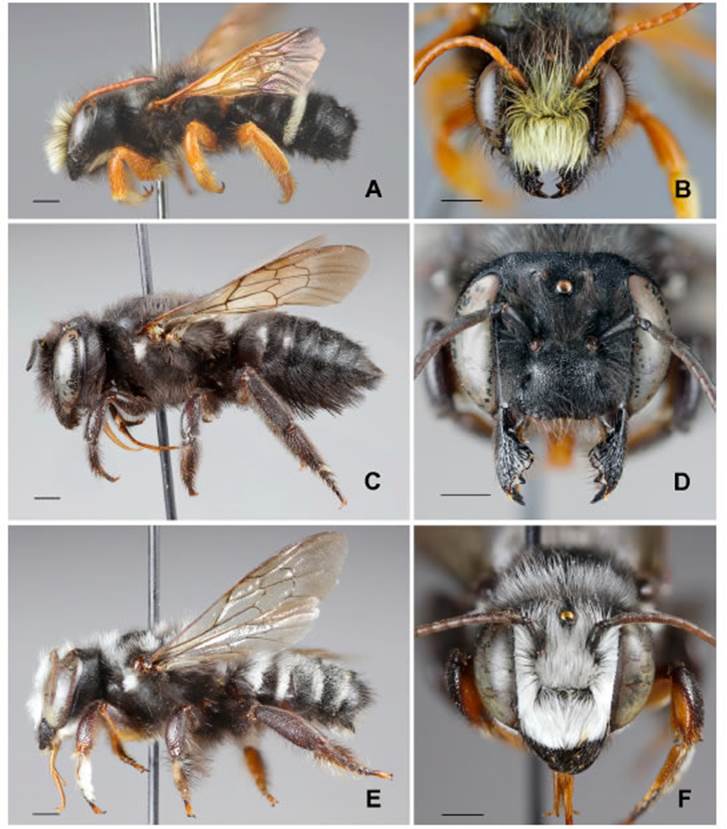
Fig. 9 A-B. Megachile euzona Pérez, male. A. lateral view. B. face. C-F. M. tetrazona Friese. C. Female, lateral view. D. Female, face. E. Male, lateral view. F. Fale, face. Scale lines = 1 mm.
Megachile euzonaPérez, 1899: 105 (Holotype male, Chile, Valparaíso, MNHN Paris, not examined).
Megachile philippiiFriese, 1905: 139-140 (Male and female syntypes, Chile, Santiago, Philippi, ZMB, not examined). Synonymy of Moure, 1953.
Megachile (Stelodides) euzona: Moure, 1953: 123-124.
Diagnosis. This species is readily distinguished by its color pattern: the integument of the body is black with orange antennae and legs, and the pubescence of the metasoma, including the female scopa, is black, except for a distinctive broad white band on T3 (Fig. 9A). This is a well-known and unmistakable species. The following notes complement the detailed original descrip tion of Pérez (1899) and the description of Moure (1953), when he proposed the subgeneric name Stelodides. Gonzalez et al. (2019) included M. eu zona in their phylogenetic study of Megachilini, and tabulated a large number of characters for this species.
Female. Body length 10.0-12.0 mm; length of forewing 7.2-8.4 mm. Structure. Inner margin of eyes nearly parallel, upper interocular distance 0.93-0.95x lower interocular distance. Distance from lateral ocellus to posterior margin of head 2x MOD. Maximum width of gena in lateral view 1x maximum width of eye. Clypeus 2.4x as wide as long, more convex on upper third, apically with transverse polished band; apical margin crenu late. Mandible with four teeth; first and second teeth of similar size; third tooth with small edge on lower margin; fourth tooth broad, incised; sec ond interspace U-shaped; third interspace asym metrically V-shaped; upper acetabular groove with apical tuft; outer premarginal impressed line with stiff setae on all its length. Hypostomal carina curving towards cranial acetabulum and forming thickened strip bordering mandibular socket. Hind basitarsus 2.8-3.0x as long as its maximum width in lateral view. Sterna without apical fasciae under scopa.
Male. Body length 9.0-11.5 mm. Forewing length 7.0-8.2 mm. Structure. Proportions of scape, pedicel and first three flagellomeres 3.0:0.7:1.0:1.3:1.6. Outer margin of foretibia sharply carinate. S5, S6, and S8, as in Figure 12C.
Comments. The preapical carina of the male T6 is variable. Some specimens have a median emargination, and crenulations or teeth lateral to it. In other specimens the carina is dentate to crenulate without any median notch.
Distribution. Argentina, provinces of Chubut and Neuquén. Chile, from Coquimbo to Temuco (Fig. 13C, locations for Chile were obtained from GBIF.org, 2023).
Material studied. Argentina. Chubut: 1 M, P.N. Los Alerces, Futalaufquen, 13-15-XII-1997, C. & M. Vardy (NHMUK); 1 M, INTA Trevelin (sitio 4; S 43° 06.025’ W 71° 33.155’), 3-XI-2007, R. González-Vaquero (MACN). Neuquén: 1 M, Lago Currué Chico, 17-XII-2010, L. Compagnucci & R. González-Vaquero (MACN); 1 F, San Martín de los Andes, I-1959, Z. Jara (MLP); 1 F, San Martín de los Andes, 7-III-1955, ex flowers of “menta” [Lamiaceae], A. Ogloblin (MLP); 1 F, San Martín de los Andes, 8-III-1955, ex Labiatae cultivada [= Lamiaceae], A. Ogloblin (MLP); 1 M, 1 F, Pucará, 1-XII-1957, S. Schajovskoi (MLP); 1 M, Lago Nahuel Huapi, 3-XII-1964, A.J. Giai (SEMC); 1 M, Confluencia, 20-XII-1964, S. Schajovskoi (MLP), 1 M, Lácar, Lago Queñi, 11 December 1999, ex Buddleja globosa [Buddlejaceae], N. Montaldo et al. (FAUBA); 1 M, Lácar, Lago Queñi, 11 December 1999, ex Lathyrus multiceps [Fabaceae], N. Montaldo et al. (FAUBA).
Megachile (Chrysosarus) tetrazona Friese
(Figs. 1F, 9C-F, 10D, 11G, 12D, 13D)
Megachile tetrazonaFriese, 1908: 64, 67 (Holotype male, Argentina, Burmeister, ZMB, examined).
Megachile albopunctataJörgensen, 1909: 225 (Lectotype female, Argentina, Mendoza, 12- XII-1907, P. Jörgensen, MLP, examined). Lectotype designation and synonymy of Durante et al. 2020.
Diagnosis. The female is recognized by its black pilosity, except for small white tufts behind the pronotal lobe and on the sides of T1 and T2 (Fig. 9C). Its metasoma is ovoid, T3 in dorsal view be ing as wide as T2. It is also distinguished by its mandible with a small cutting edge on the third tooth and a broad, truncate upper tooth (Fig. 1F). The male is readily recognized by the anterior basitarsus, which is widest basally, at the level of the distal end of the strigillar concavity, and then tapers apically, having the under surface flattened, glabrous, and polished (Fig. 10D); the basitarsus is yellowish brown basally and black apically. The anterior tibial spur has a black apex in both sexes; it is truncate in the male. Both sexes of this species have been redescribed in de tail by Durante et al. (2020). The following notes complement that redescription.
Female. Body length 11.5-14.6 mm; length of forewing 7.9-9.5 mm. Structure. Inner margin of eyes nearly parallel, upper interocular distance 0.97-1.00x lower interocular distance. Distance from lateral ocellus to posterior margin of head 1.9-2.2x MOD. Maximum width of gena in lat eral view 0.72-0.75x maximum width of eye. Clypeus 2.7x as wide as long, more convex on upper third, apically with transverse polished band; apical margin weakly crenulate. Mandible with four teeth; first and second teeth of similar size; fourth tooth broad, truncate; second inter space with small cutting edge; second and third interspaces U-shaped; upper acetabular groove with apical tuft; outer premarginal impressed line with stiff setae on all its length. Hypostomal carina curving towards cranial acetabulum and forming thickened strip bordering mandibular socket. Hind basitarsus 2.8-3.0x as long as its maximum width in lateral view. Sterna without apical fasciae under scopa.
Male. Body length 11.6-12.6 mm. Forewing length 6.9-8.8 mm. Structure. Proportions of scape, pedicel and first three flagellomeres 2.9:0.8:1.0:1.5:1.7. Outer margin of foretibia sharply carinate. S5, S6, and S8, as in Figure 12D.
Distribution. Argentina, provinces of Buenos Aires, Catamarca, Córdoba, La Pampa, La Rioja, Mendoza, Río Negro, San Juan, and San Luis. Chile, Los Andes (Fig. 13D).
Material studied. All specimens cited by Durante et al. (2020: 28) were examined; their data are not repeated here, but are included in the distribution map.












 uBio
uBio 

